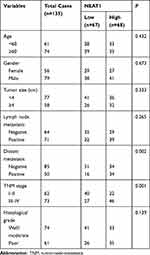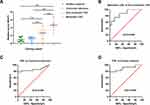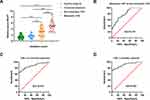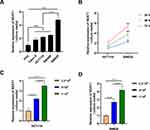Back to Journals » Cancer Management and Research » Volume 12
The Diagnostic and Prognostic Value of Serum lncRNA NEAT1 in Colorectal Cancer
Authors Wang Y, Zhang D, Zhang C, Sun Y
Received 30 June 2020
Accepted for publication 10 September 2020
Published 2 November 2020 Volume 2020:12 Pages 10985—10992
DOI https://doi.org/10.2147/CMAR.S269978
Checked for plagiarism Yes
Review by Single anonymous peer review
Peer reviewer comments 3
Editor who approved publication: Dr Eileen O'Reilly
Yong Wang, Dongsheng Zhang, Chuan Zhang, Yueming Sun
Department of Colorectal Surgery, The First Affiliated Hospital of Nanjing Medical University, Nanjing 210029, Jiangsu Province, People’s Republic of China
Correspondence: Yueming Sun Email [email protected]
Background: Colorectal cancer (CRC) is one of the most frequent types of gastrointestinal tract cancers. Abnormal expression of long non-coding RNAs (lncRNAs) has been shown to be closely associated with the progression of CRC. The aim of the current study was to determine the diagnostic and prognostic value of lncRNA nuclear paraspeckle assembly transcript 1 (NEAT1) in CRC.
Methods: The expression levels and diagnostic value of serum NEAT1 were evaluated in the training and validation cohorts. Then, the prognosis value of serum NEAT1 in CRC was further explored.
Results: The expression levels of serum NEAT1 were significantly higher in CRC, especially in metastatic CRC, than in colorectal adenoma and healthy controls. In addition, serum NEAT1 could well differentiate metastatic CRC from non-metastatic CRC and CRC from colorectal adenoma or healthy controls. Moreover, the metastatic CRC cells secreted more NEAT1 than the control cells. Upregulation of serum NEAT1 was significantly associated with poor clinical outcome of CRC, and serum NEAT1 was identified as an independent prognostic factor for CRC.
Conclusion: Serum NEAT1 might be a promising diagnostic and prognostic biomarker for CRC.
Keywords: serum NEAT1, prognosis, diagnosis, colorectal cancer
Introduction
Colorectal cancer (CRC) is one of the most frequent malignancies affecting the digestive system and the third leading cause of cancer-related mortality.1 Currently, the major therapeutic options for CRC include surgical resection, chemotherapy and radiotherapy. Despite the advances made in the CRC screening tests and treatment strategies, the clinical outcome of CRC remains poor.2,3 Local recurrence or distant metastases are the primary reasons for the unfavorable prognosis of CRC. Although the Tumor, Node, Metastasis (TNM) staging system provides important and useful guidelines for the selection of treatments, patients at similar TNM stage can have completely different clinical outcomes.4 Therefore, it is urgently needed to develop novel biomarkers for the diagnosis and prognosis of CRC.
Long non-coding RNAs (lncRNAs) are a sub-class of non-coding RNAs that are longer than 200 nucleotides (nt) in length.5 LncRNAs have been demonstrated to play important roles in multiple biological processes such as proliferation, migration, apoptosis, differentiation and cell cycle.6,7 The expression patterns of lncRNAs are frequently abnormally expressed in human cancers. This indicates not only that these molecules might actively involve in the onset and progression of tumors but might serve as promising biomarkers for monitoring disease development. Recently, accumulative evidence has shown that lncRNAs are crucial for the tumorigenesis of CRC. For instance, the expression level of lncRNA PVT1 was significantly increased in CRC. In addition, upregulation of PVT1 inhibited proliferation, migration and invasion of CRC cells, and opposite findings were observed PVT1 was suppressed.8 LncRNAs can be stably detected in the blood and other biofluids. Therefore, considerable attention has been focused on using the circulating lncRNAs as biomarkers for the early detection and prognosis prediction of CRC.9,10
Nuclear paraspeckle assembly transcript 1 (NEAT1) is an indispensable component of nuclear paraspeckles. NEAT1 has been reported to be highly expressed and play an oncogenic role in various types of cancer such as non-small cell lung cancer, CRC and pancreatic cancer.11–13 However, whether circulating NEAT1 was deregulated in CRC as well as its potential diagnostic and prognostic values in CRC remain unknown. Therefore, the aim of the current study was to elucidate the clinical significance of serum NEAT1 in CRC.
Patients and Methods
Study Design and Patients
This study was approved by the Research and Ethical Committee of The First Affiliated Hospital of Nanjing Medical University and was performed in accordance with the Declaration of Helsinki. Written informed consents were obtained from all participants. For the training cohort, the levels of serum NEAT1 were evaluated in a small subset of participants which includes 8 metastatic CRC patients, 20 non-metastatic CRC patients, 15 colorectal adenoma patients, and 20 gender- and age-matched healthy subjects. For the independent validation cohort, a total of 45 metastatic CRC patients, 85 non-metastatic CRC patients, 50 colorectal adenoma patients, and 70 healthy controls were enrolled. In addition, postoperative sera were collected from 93 CRC patients 2 weeks after surgery. All CRC patients were staged according to the American Joint Committee on Cancer TNM staging system. The clinicopathological features of the CRC patients are summarized in Table 1.
 |
Table 1 Correlations Between Serum NEAT1 and Clinicopathological Features in CRC Patients |
Cell Culture
Four CRC cell lines including Caco-2, HCT116, SW480, and SW620 and the normal colon epithelial cell line FHC were purchased from American Type Culture Collection (Manassas, VA, USA). All the cells lines were cultured in Dulbecco’s Modified Eagle Medium (DMEM) complemented with 10% fetal bovine serum and 1% streptomycin/penicillin at 37°C with 5% of CO2.
Serum Sample Collection
Peripheral blood samples were collected and centrifuged at 3000 g for 20 min at 4°C to remove debris. The serum samples were transferred to new sterile tubes and stored at −80°C for further analysis.
Reverse Transcription Quantitative Polymerase Chain Reaction (RT-qPCR)
The total RNA was isolated from serum and cell culture media samples with Trizol reagent (Invitrogen, Carlsbad, CA, USA). Reverse transcription was carried out using M-MLV Reverse Transcriptase kit (Invitrogen) based on the manufacturer’s protocol. The amplification of first-strand complementary DNA was performed using SYBR Green qPCR Master Mix (Takara, Dalian, China) on an ABI 7500 system (Applied Biosystems, Foster City, CA, USA). The relative expression of NEAT1 was calculated by the comparative Ct method. GAPDH was used as an endogenous control. The amplification procedure was as follows: 95°C for 5 min, followed by 40 cycles of 95°C for 15 s and 60°C for 1 min. The primers used were: NEAT1 forward, 5′-CTTCCTCCCTTTAACTTATCCATTCAC-3′, NEAT1 reverse, 5′-CTCTTCCTCCACCATTACCAACAATAC-3′; GAPDH forward, 5′-CGGAGTC-AACGGATTTGGTCGTAT-3′, GAPDH reverse, 5′-AGCCTTCTCCATGGTGGTGAAGAC-3′.
Statistical Analysis
Statistical analysis was performed with GraphPad Prism 8.0 (GraphPad Software, San Diego, CA, USA). The Kruskal–Wallis test was used to compare the serum NEAT1 among metastatic CRC, non-metastatic CRC, colorectal adenoma and healthy controls or among the culture medium from different cell lines. Receiver operating characteristic curve (ROC) and the area under the curve (AUC) were employed to assess the discriminative power of serum NEAT1. Chi-square test was used to evaluate the correlations between serum NEAT1 levels and clinicopathological features of CRC. Survival curves were estimated using the Kaplan–Meier method, and differences were compared by the Log rank test. The association between serum NEAT1 levels and overall survival was revealed with univariate and multivariate analyses. P value <0.05 was considered to be statistically significant.
Results
Serum NEAT1 Was Significantly Increased in CRC in the Discovery Cohort
The expression level of circulating NEAT1 was significantly higher in CRC patients than in patients with colorectal adenoma and healthy controls (***P<0.001). In addition, serum NEAT1 was especially higher in metastatic CRC compared to non-metastatic CRC (***P<0.001) (Figure 1A). ROC analyses revealed that serum NEAT1 showed good performance for differentiating metastatic CRC from non-metastatic CRC with an AUC value of 0.869 (Figure 1B). In addition, serum NEAT1 could identify CRC patients from patients with colorectal adenoma and healthy controls with an AUC value of 0.860 and 0.895, respectively (Figure 1C and D).
The Expression Patterns of Serum NEAT1 in CRC Were Validated in an Independent Cohort
In the independent validation cohort, serum NEAT1 levels were remarkably elevated in CRC patients, especially in metastatic CRC, when compared to patients with colorectal adenoma and healthy controls (***P<0.001) (Figure 2A). ROC analyses revealed that serum NEAT1 was able to differentiate metastatic CRC from non-metastatic CRC with an AUC value of 0.797 (Figure 2B). The AUC values of serum NEAT1 for identifying CRC patients from patients with colorectal adenoma or healthy controls were 0.875 and 0.907, respectively (Figure 2C and D).
The NEAT1 Levels Were Increased in the Culture Media from CRC Cell Lines
As shown in Figure 3A, the expression level of NEAT1 was dramatically upregulated in the culture media from CRC cell lines, compared to that from FHC. In addition, the metastatic CRC cell line SW620 secreted much more NEAT1 into culture media than the other three CRC cell lines (***P<0.001) (Figure 3A). Then, we compared the NEAT1 expression in HCT116 and SW620 cells in a time-dependent manner. Our results showed that NEAT1 in the culture media from both cell lines increased with time, and SW620 secreted more NEAT1 than HCT116 at each time point (**P<0.01, ***P<0.001) (Figure 3B). Similarly, the expression of NEAT1 in the culture media from both cell lines increased with increasing numbers of cells (***P<0.001) (Figure 3C and D).
Serum NEAT1 Was Closely Associated with Unfavorable Clinicopathological Features of CRC
The median value of serum NEAT1 was used as the cut-off to divide the CRC patients into high (n=68) and low (n=67) serum NEAT1 group. The results showed that serum NEAT1 was significantly associated with TNM stage (P=0.001) and distant metastasis (P=0.002). However, no strong correlations were found between serum NEAT1 and age, gender, tumor size, lymph node metastasis and histological grade (Table 1)
Upregulation of Serum NEAT1 Was Associated with Poor Prognosis of CRC
The expression level of serum NEAT1 was significantly lower in the post-operative samples compared to the paired pre-operative samples (P=0.001) (Figure 4A). For the metastatic CRC cases, the patients in the high serum NEAT1 group had worse overall survival than those in the low serum NEAT1 group (P=0.009) (Figure 4B). Similarly, for all the CRC cases, the patients in the high serum NEAT1 group had worse shorter overall survival compared to those in the low serum NEAT1 group (P<0.001) (Figure 4C). Multivariate analysis showed that serum NEAT1 was an independent prognostic factor for CRC (Hazard ratio=2.731, 95% CI=1.201–5.863, P=0.011) (Table 2).
 |
Table 2 Multivariate Analysis of Prognostic Factors for CRC |
Discussion
In this study, our results showed that, compared to the colorectal adenoma and healthy controls, the expression level of serum NEAT1 was significantly increased in CRC, especially in metastatic CRC in both the discovery and validation cohorts. In addition, serum NEAT1 well distinguished CRC from colorectal adenoma or healthy controls as well as metastatic CRC from non-metastatic CRC. The metastatic CRC cells secreted much more NEAT1 into the culture medium compared to the controls. Moreover, increased serum NEAT1 was closely associated with worse clinicopathological features and survival in CRC. Furthermore, serum NEAT1 was identified as an independent prognostic factor for CRC. Taken together, serum NEAT1 might serve as a robust and reliable biomarker for predicting the prognosis of CRC.
Consistent results have demonstrated that NEAT1 act as an oncogene in the initiation and progression of CRC. For instance, the expression level of NEAT1 was significantly increased in CRC tissues compared to the controls. In addition, both in vitro and in vivo evidence suggested that NEAT1 was important for maintaining the oncogenic activities of CRC cells.14 Similarly, knockdown of NEAT1 enhanced the sensitivity of CRC cells to 5-FU.15 MicroRNAs (miRNAs) are a class of small non-coding RNAs that play a central role in posttranscriptional regulation of protein-coding genes. NEAT1 is demonstrated to play a tumor-promoting role in CRC mainly through the lncRNA-miRNA-mRNA axis. For instance, miR-34a, miR-205-5p, miR-193a-3p were identified as a target of NEAT1.12,15,16 NEAT1 can act as a sponge of these miRNAs, reducing their regulatory effect on the target mRNAs.
In addition to CRC, NEAT1 has been shown to promote tumorigenesis in other types of cancer. For example, NEAT1 was significantly upregulated in hepatocellular carcinoma (HCC) tissues compared to the adjacent normal tissues. Downregulation of NEAT1 dramatically inhibited proliferation and invasion as well as promoted apoptosis in HCC cells.17 Similarly, NEAT1 was overexpressed in breast cancer and closely associated with advanced clinical stages and positive lymph node metastasis. Suppression of NEAT1 inhibits breast cancer cell proliferation, migration and invasion.18 Wang et al also showed that NEAT1 promoted the proliferation and invasion of endometrial cancer cells by regulating the miR-144-3p/EZH2 axis.19 Interestingly, the role of NEAT1 in tumorigenesis seems to depend on the tumor types. It is also possible that NEAT1 plays a tumor-suppressive role in cancer development. The expression level of NEAT1 was significantly lower in glioma tissues and cells. Enforced expression of NEAT1 suppressed the oncogenic activities of glioma cells.20 NEAT1 was also significantly reduced in acute myeloid leukemia (AML). Upregulation of NEAT1 inhibited the cell growth, migration and invasion as well as promoted apoptosis of AML cells.21
As we have mentioned above, NEAT1 might be deregulated in other malignancies. Therefore, it is possible that circulating NEAT1 is upregulated or downregulated in these malignancies or non-cancer diseases. The plasma NEAT1 was significantly increased in NSCLC patients compared to the controls.22 Huang et al reported that circulating NEAT1 was remarkably higher in sepsis patients than in healthy subjects. In addition, the upregulation of circulating NEAT1 was closely associated with disease risk, elevated severity and unfavorable prognosis in sepsis patients.23 Recently, circulating tumor DNA (ctDNA) has emerged as a promising diagnostic and prognostic tool for CRC. For instance, ctDNA exhibits good performance for monitoring treatment response, identifying CRC cases with recurrence, and monitoring therapeutic resistance in metastatic CRC patients.24 Therefore, further studies are warranted to confirm whether combining circulating ctDNA and serum NEAT1 could enhance the diagnosis and prognosis prediction of CRC. Therefore, to avoid potential misinterpretation, we should combine other robust biomarkers of CRC (ctDNA), clinicopathological data and circulating NEAT1 for the diagnosis and prognosis prediction of CRC. One limitation of our study was the relatively small sample size. Further studies with a large sample size are warranted to validate our findings. In addition, the molecular mechanisms for the role of NEAT1 in CRC progression need further exploration.
In conclusion, we have demonstrated that serum NEAT1 is significantly increased in CRC, especially in metastatic CRC. In addition, the upregulation of serum NEAT1 is closely associated with the unfavorable prognosis of CRC. Therefore, serum NEAT1 might be a novel potential diagnostic and prognostic biomarker for CRC.
Funding
The current work was funded by the Medical Project of Jiangsu Province (303070496IC17).
Disclosure
The authors report no conflicts of interest for this work.
References
1. Siegel RL, Miller KD, Jemal A. Cancer statistics, 2015. CA Cancer J Clin. 2015;65(1):5–29. doi:10.3322/caac.21254
2. Baxter NN, Warren JL, Barrett MJ, Stukel TA, Doria-Rose VP. Association between colonoscopy and colorectal cancer mortality in a US cohort according to site of cancer and colonoscopist specialty. J Clin Oncol. 2012;30(21):2664–2669. doi:10.1200/JCO.2011.40.4772
3. Weizman AV, Nguyen GC. Colon cancer screening in 2010: an up-date. Minerva Gastroenterol Dietol. 2010;56(2):181–188.
4. Ji D, Qiao M, Yao Y, et al. Serum-based microRNA signature predicts relapse and therapeutic outcome of adjuvant chemotherapy in colorectal cancer patients. EBioMedicine. 2018;35:189–197. doi:10.1016/j.ebiom.2018.08.042
5. Derrien T, Johnson R, Bussotti G, et al. The GENCODE v7 catalog of human long noncoding RNAs: analysis of their gene structure, evolution, and expression. Genome Res. 2012;22(9):1775–1789. doi:10.1101/gr.132159.111
6. Mattick JS, Makunin IV. Non-coding RNA. Hum Mol Genet. 2006;15(Spec No 1):R17–R29. doi:10.1093/hmg/ddl046
7. Cheetham SW, Gruhl F, Mattick JS, Dinger ME. Long noncoding RNAs and the genetics of cancer. Br J Cancer. 2013;108(12):2419–2425. doi:10.1038/bjc.2013.233
8. Chai J, Guo D, Ma W, et al. A feedback loop consisting of RUNX2/LncRNA-PVT1/miR-455 is involved in the progression of colorectal cancer. Am J Cancer Res. 2018;8(3):538–550.
9. Shi J, Li X, Zhang F, et al. Circulating lncRNAs associated with occurrence of colorectal cancer progression. Am J Cancer Res. 2015;5(7):2258–2265.
10. Galamb O, Bartak BK, Kalmar A, et al. Diagnostic and prognostic potential of tissue and circulating long non-coding RNAs in colorectal tumors. World J Gastroenterol. 2019;25(34):5026–5048. doi:10.3748/wjg.v25.i34.5026
11. Chen LM, Niu YD, Xiao M, Li XJ, Lin H. LncRNA NEAT1 regulated cell proliferation, invasion, migration and apoptosis by targeting has-miR-376b-3p/SULF1 axis in non-small cell lung cancer. Eur Rev Med Pharmacol Sci. 2020;24(9):4810–4821.
12. Liu H, Li A, Sun Z, Zhang J, Xu H. Long non-coding RNA NEAT1 promotes colorectal cancer progression by regulating miR-205-5p/VEGFA axis. Hum Cell. 2020;33(2):386–396. doi:10.1007/s13577-019-00301-0
13. Feng Y, Gao L, Cui G, Cao Y. LncRNA NEAT1 facilitates pancreatic cancer growth and metastasis through stabilizing ELF3 mRNA. Am J Cancer Res. 2020;10(1):237–248.
14. Zhang M, Weng W, Zhang Q, et al. The lncRNA NEAT1 activates Wnt/beta-catenin signaling and promotes colorectal cancer progression via interacting with DDX5. J Hematol Oncol. 2018;11(1):113. doi:10.1186/s13045-018-0656-7
15. Liu F, Ai FY, Zhang DC, Tian L, Yang ZY, Liu SJ. LncRNA NEAT1 knockdown attenuates autophagy to elevate 5-FU sensitivity in colorectal cancer via targeting miR-34a. Cancer Med. 2020;9(3):1079–1091. doi:10.1002/cam4.2746
16. Zhu Z, Du S, Yin K, et al. Knockdown long noncoding RNA nuclear paraspeckle assembly transcript 1 suppresses colorectal cancer through modulating miR-193a-3p/KRAS. Cancer Med. 2019;8(1):261–275. doi:10.1002/cam4.1798
17. Kou JT, Ma J, Zhu JQ, et al. LncRNA NEAT1 regulates proliferation, apoptosis and invasion of liver cancer. Eur Rev Med Pharmacol Sci. 2020;24(8):4152–4160.
18. Yan L, Zhang Z, Yin X, Li Y. lncRNA NEAT1 facilitates cell proliferation, invasion and migration by regulating CBX7 and RTCB in breast cancer. Onco Targets Ther. 2020;13:2449–2458. doi:10.2147/OTT.S240769
19. Wang W, Ge L, Xu XJ, et al. LncRNA NEAT1 promotes endometrial cancer cell proliferation, migration and invasion by regulating the miR-144-3p/EZH2 axis. Radiol Oncol. 2019;53(4):434–442. doi:10.2478/raon-2019-0051
20. Liu D, Zou Z, Li G, Pan P, Liang G. Long noncoding RNA NEAT1 suppresses proliferation and promotes apoptosis of glioma cells via downregulating MiR-92b. Cancer Control. 2020;27(1):1073274819897977. doi:10.1177/1073274819897977
21. Feng S, Liu N, Chen X, Liu Y, An J. Long non-coding RNA NEAT1/miR-338-3p axis impedes the progression of acute myeloid leukemia via regulating CREBRF. Cancer Cell Int. 2020;20:112. doi:10.1186/s12935-020-01182-2
22. Hu X, Bao J, Wang Z, et al. The plasma lncRNA acting as fingerprint in non-small-cell lung cancer. Tumour Biol. 2016;37(3):3497–3504. doi:10.1007/s13277-015-4023-9
23. Huang Q, Huang C, Luo Y, He F, Zhang R. Circulating lncRNA NEAT1 correlates with increased risk, elevated severity and unfavorable prognosis in sepsis patients. Am J Emerg Med. 2018;36(9):1659–1663. doi:10.1016/j.ajem.2018.06.008
24. Bi F, Wang Q, Dong Q, Wang Y, Zhang L, Zhang J. Circulating tumor DNA in colorectal cancer: opportunities and challenges. Am J Transl Res. 2020;12(3):1044–1055.
 © 2020 The Author(s). This work is published and licensed by Dove Medical Press Limited. The full terms of this license are available at https://www.dovepress.com/terms.php and incorporate the Creative Commons Attribution - Non Commercial (unported, v3.0) License.
By accessing the work you hereby accept the Terms. Non-commercial uses of the work are permitted without any further permission from Dove Medical Press Limited, provided the work is properly attributed. For permission for commercial use of this work, please see paragraphs 4.2 and 5 of our Terms.
© 2020 The Author(s). This work is published and licensed by Dove Medical Press Limited. The full terms of this license are available at https://www.dovepress.com/terms.php and incorporate the Creative Commons Attribution - Non Commercial (unported, v3.0) License.
By accessing the work you hereby accept the Terms. Non-commercial uses of the work are permitted without any further permission from Dove Medical Press Limited, provided the work is properly attributed. For permission for commercial use of this work, please see paragraphs 4.2 and 5 of our Terms.




